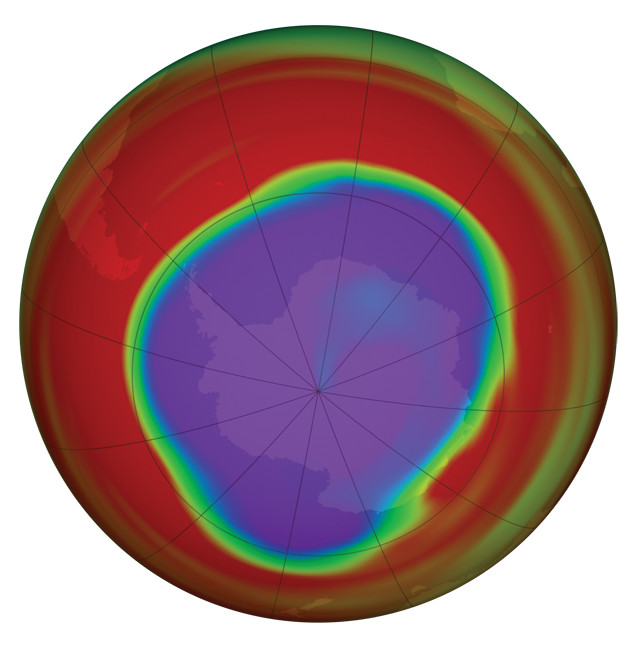
by Mary Caperton Morton Monday, June 8, 2015

Concentrations of hydrochloric acid measured over the South Pole on Aug. 13, 2004 (warm colors indicate higher concentrations). Credit: NASA/Goddard Space Flight Center.
Levels of the atmospheric pollutant hydrogen chloride have increased substantially in the lower stratosphere over the Northern Hemisphere since 2007, according to a new study. The increase, however, is not due to an influx of chlorine, but rather to a side effect of the recent slowing of stratospheric circulation that was first reported in 2005.
Large amounts of chlorine were introduced into the atmosphere from the 1970s through the 1990s in the form of chlorofluorocarbons, or CFCs, found in refrigerants, aerosols and solvents. In the atmosphere, CFCs deplete the protective ozone layer, allowing more harmful ultraviolet radiation to reach Earth’s surface. Alarming ozone loss over Antarctica prompted many nations to ratify the Montreal Protocol, which went into force in 1989 and phased out CFC use through the early 1990s. It largely worked, and since 1993, hydrogen chloride in the atmosphere, which can form as a byproduct of the breakdown of CFCs, has decreased by about 1 percent per year on average.
This was confirmed by the new study, led by Emmanuel Mahieu of the University of Liège in Belgium, which used satellite data and observations from eight ground-based stations to chart a continuous decline of hydrogen chloride concentrations in the Southern Hemisphere over the last 14 years. However, in the Northern Hemisphere the researchers found a yearly increase of 1.1 to 3.4 percent over the same period.
Simulations suggested that this increase is due to a slowdown in atmospheric circulation in the Northern Hemisphere, which is helping to recruit hydrogen chloride from the Southern Hemisphere, rather than continued CFC or hydrogen chloride pollution. Previous studies have shown that this atmospheric slowdown is likely a product of natural atmospheric variability that occurs on decadal timescales. “This short-term dynamical variability will also affect other stratospheric tracers and needs to be accounted for when studying the evolution of the stratospheric ozone layer,” Mahieu and colleagues wrote in Nature.
“The study confirms … that the ozone layer is likely to fully recover during the second half of this century,” said study co-author David Griffith of the University of Wollongong in Australia in a statement. “However, our results show that atmospheric variability and perhaps climate change can significantly modify the path toward full recovery.”
© 2008-2021. All rights reserved. Any copying, redistribution or retransmission of any of the contents of this service without the expressed written permission of the American Geosciences Institute is expressly prohibited. Click here for all copyright requests.